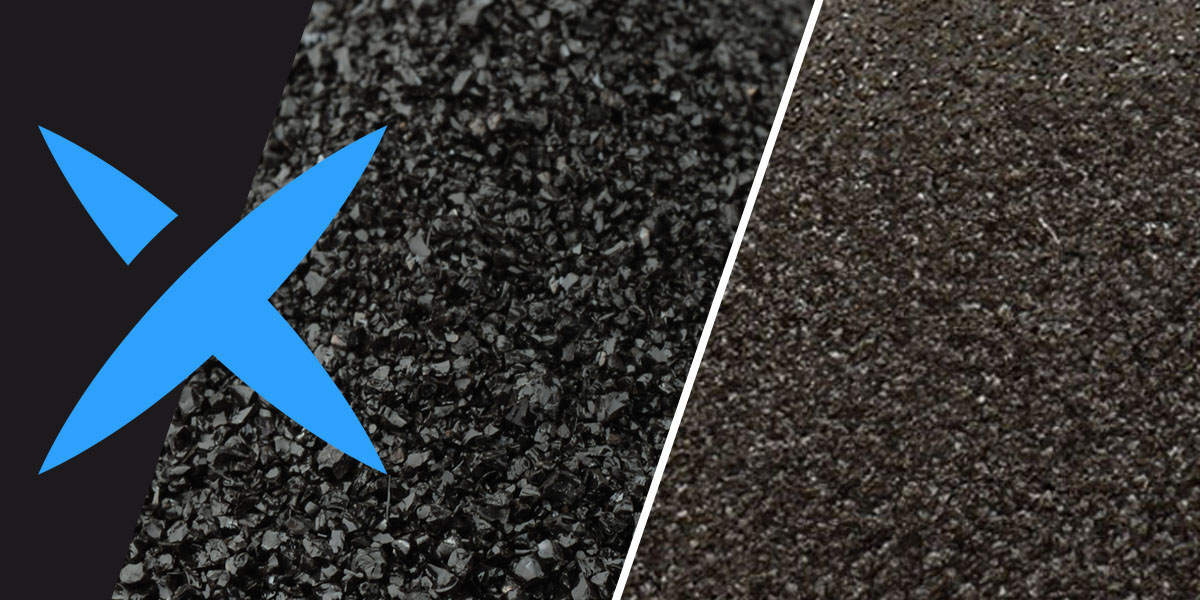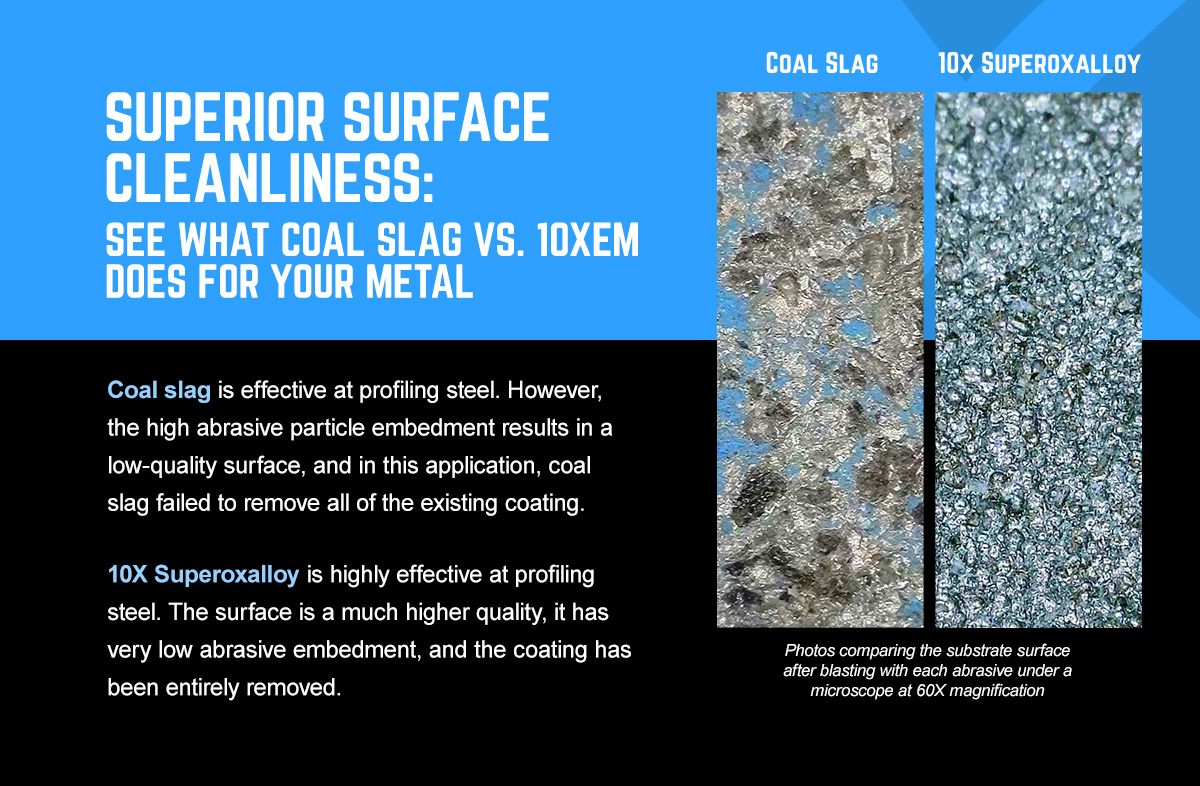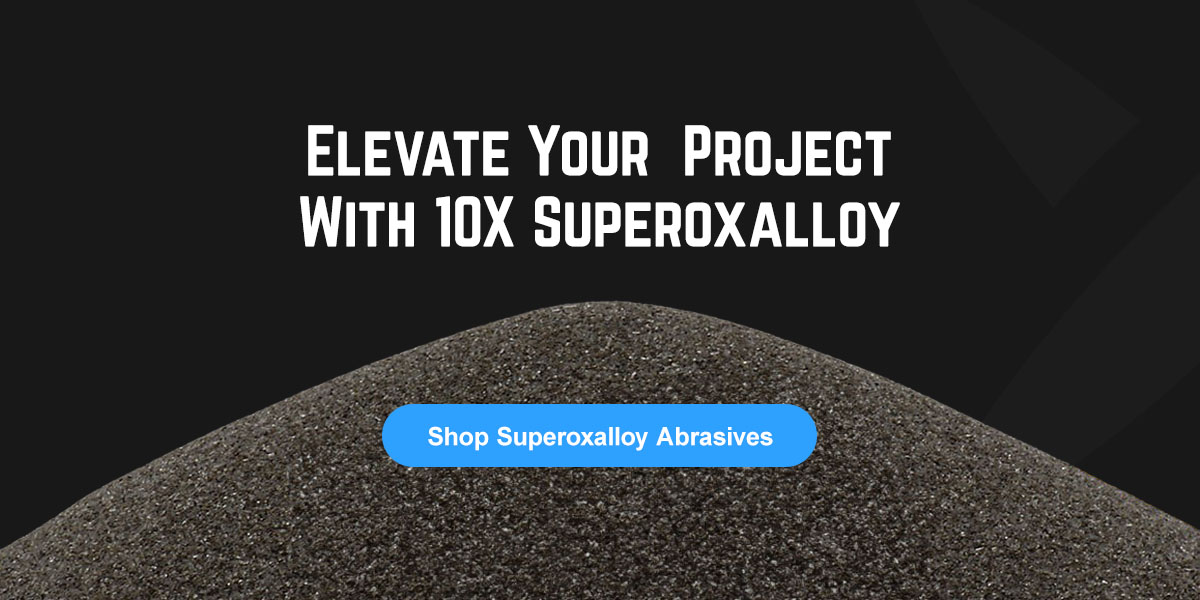Coal Slag vs. 10X Superoxalloy Abrasives

Coal slag and superoxalloy are both commonly used in surface preparation, but these two popular types of abrasive blasting media differ vastly in terms of safety, surface finish, and reusability.
Our guide will provide an in-depth comparison of the two products so you can make an informed decision on your next blasting media purchase.
What to Consider When Choosing Abrasive Media
The media you select for blasting projects has a significant impact on blasting results as well as the safety and productivity of your crew. The following are a few key factors to consider when weighing coal slag and its alternatives.
Abrasive Safety
Safety is a significant concern at any job site. As using abrasive media produces high volumes of dust, lung diseases are a common issue that regulators work to protect workers from within this industry. It’s therefore useful to know the lung toxicity of different abrasive media according to factors known as the three D’s — dose, dimension, and duration. Here’s how coal slag blasting media and superoxalloy compare across these categories.
Dose
How much exposure can workers face? Superoxalloy abrasive particles are formed by rapidly cooling a molten mineral melt, which gives them high impact strength. Particle strength offers performance advantages of high working speed and very low abrasive consumption, but it also means that fewer particles shatter into dust when blasting. The dust levels are extremely low compared to coal slag abrasives. And thankfully, the human and animal studies reviewed by IARC involved exposures to dust concentrations more than six times higher than what OSHA allows. On the other hand, coal slag lacks enough testing necessary to know what a safe exposure limit is. The limited results available suggest that relatively low exposures could cause serious cell damage.
Dimension
How do particle size and shape affect toxicity? This part is more complicated and requires an understanding of how our lungs protect themselves. First, the upper respiratory tract is designed to filter everything but the smallest particles, less than about 10 microns. Those small particles that reach the deep gas exchange regions of the lungs are removed primarily by macrophage cells. Chronic effects and cancer occur when the macrophage cells are damaged by the dust particles. Long and thin particles like insulation fibers are even more damaging to macrophage cells than particles. The good news is that the direct exposure studies of mineral wool dust, the same dust as superoxalloy dust, showed that neither small fibers nor small particles were toxic. Both are dissolved and removed. Superoxalloy abrasives are biosoluble in the lungs. Coal slag particles do not appear to be, and that is a concern.
Duration
How long do the dust particles stay in the lungs? The final D stands for “duration,” or the length of time the particles stay within a worker’s lungs. When dust particles are not able to be removed by macrophage cells and other defense mechanisms in our lungs, they remain there and initiate chronic effects, lung fibrosis, and possibly cancer. Crystalline silica and asbestos are examples of durable, or bio-persistent, dust particles that are known to be human carcinogens. They kill macrophage cells and remain in the lungs for very long periods of time. They have been observed in the lungs of exposed people on autopsy decades after exposure, suggesting that coal slag exposure to lung tissue is unsafe for your workers. The dust particles from mineral wool insulation and now superoxalloy abrasives are proven not to be damaging to macrophage cells. They are soluble and able to be dissolved both inside macrophage cells and in the fluids surrounding the macrophage cells. As a result, superoxalloy particles are rapidly cleared without causing harm.
On the other hand, coal slag is the byproduct of burning coal, which is common in coal-fired power plants. Because coal slag is likely bio-persistent, the dust particles from blasting with coal slag should be avoided.
The Existing Coating
When choosing a blasting media, consider the substrate’s current surface coating. The coating you’re working with will dictate whether your chosen product will be effective, helping reduce the likelihood of needing rework.
Coal slag sandblasting media is a popular choice for removing rust, paint, and select coatings from metal. However, it is less effective in heavy-duty applications like removing stubborn contaminants or thicker finishes. In contrast, 10X superoxalloy effectively strips rust, corrosion, scale, and existing coatings from metal surfaces. You can also use it on aluminum and stainless steel surfaces, making it a highly effective coal slag alternative.
Impact on Substrate Integrity
Some projects call for white metal or SSPC SP-5 finishes and complete coating removal, whereas others require only a brush-off blast. Understanding what level of surface cleanliness your job requires will help you choose the best media and make the most accurate estimate for your needs.

Coal slag contains angular particles, making this an effective abrasive media for creating profiled steel. However, an important item to note when using coal slag sandblasting media is that there is often significant abrasive particle embedment after blasting. This impacts the integrity of your substrate. With higher levels of coal slag particle embedment, your substrate’s quality is lower, and the coating system has to make up for this lack of quality, potentially reducing the coating’s in-service life expectancy. It is important to factor this in, and depending upon the cleanliness requirements, you may need a secondary blasting step with coal slag sandblasting media. In contrast, superoxalloy abrasives have a patented variety of particle shapes that offer a cleaner, profiled finish with little to no abrasive particle embedment. Superoxalloy abrasive blasting media also extends the coating window of opportunity because it delays the onset of flash rusting.
Additionally, superoxalloy abrasives are viable for dry, wet, or vapor-blasting applications. On the other hand, coal slag is only usable for dry abrasive blasting applications, as exposure to moisture will cause coal slag sandblasting media to mud up or cake.
Cost Considerations
Containment, abrasive reusability, and spent abrasive disposal have significant impacts on the overall cost of using an abrasive. Below are some key parameters to consider when comparing coal slag blasting media and superoxalloy.
Containment
Blasting media produces varying levels of dust. Coal slag falls on the higher end of the dust-generation scale, which is why some municipalities restrict its use.
As blasting projects generally occur in urban areas, teams often need portable structures to contain the dust. 10X Superoxalloy offers substantially lower dust levels during blasting, which results in a need for less total containment.
Abrasive Reuse
Reusing materials is better for the environment and enables you to save money on each project. Coal slag blasting abrasive often shatters during the blasting process, making it impossible to use again for this application — it can, however, be recycled into cement and select other materials.
In contrast, 10X Superoxalloy abrasives are much better at maintaining their shape, making their abrasive particles effective for up to six blasting cycles with KinetiX and DynamiX and ten or more cycles with EpiX.
Cleanup and Disposal
After blasting with coal slag, teams must clean up the spent abrasive media and dust. Doing this with an industrial vacuum is preferable, as it will contain all the contaminants. The contaminants in coal slag include leachable heavy metals, which are harmful to the environment and can create regulatory issues when disposing of the spent coal slag blasting abrasive. Workers must follow strict protocols to dispose of or recycle this material.
In contrast, 10X superoxalloy is simple to clean up at the end of a project. It has no shipping or disposal regulations because it is mineral wool material. Moving and discarding spent superoxalloy abrasives is much faster, safer, lower cost, and easier. In summary, 10X’s superoxalloy abrasives have a much lower cost per square foot because of the higher particle efficiency during blasting, substantially lower abrasive consumption per unit area, this material can be reused numerous times, and it has no environmental regulatory concerns and can therefore be disposed of and handled as a non-hazardous material.
How to Determine Which Abrasive Is Best for Your Blasting Needs
Choosing the right abrasive blasting media for your project helps you achieve superior results while shortening the completion time and minimizing your total blasting costs. Here are some important considerations to ensure you make the right choice:
- Consider worker safety: Safeguarding workers’ health and maintaining health and safety regulations on-site is paramount. Superoxalloy is considered a safe abrasive media by various regulatory bodies, such as the California Air Resources Board (CARB).
- Prioritize your environmental stance: Superoxalloy abrasives consist of 100% recycled mineral wool material byproduct — a substance that can be left on the ground because it has a clean Toxicity Characteristic Leaching Protocol (TCLP.) Officials have also approved it as a soil amendment in many locations.
- Examine your project needs: The existing coating and desired finish are crucial considerations when choosing a blasting media. While coal slag blasting abrasives may benefit more aggressive applications, superoxalloy allows greater versatility for all project types.

Elevate Your Project With 10X Superoxalloy
Though once favored as a low-silica abrasive blasting media, coal slag is toxic enough that many blasting companies have begun searching for safer abrasives. A popular alternative to coal slag is Superoxalloy abrasive blasting media, which offers an effective solution as it delivers superior surface finishes, cost benefits, and project efficiency while maintaining worker safety.
Click here to learn how superoxalloy abrasives performed for the U.S. NAVY on the USS Texas nuclear submarine.
10X Engineering offers a range of superoxalloy products to support different applications. We’ll also take the time to get to know your project, enabling us to recommend the best product for your needs. Contact us today to source safer and more cost-effective abrasive blasting media that delivers exceptional results!
